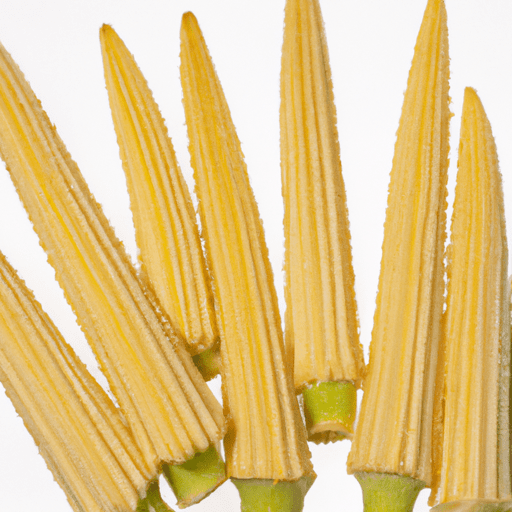The Versatile Delight: Baby Whole Corn
Are you looking to add a touch of sweetness and crunch to your dishes? Look no further than baby whole corn! This petite and vibrant ingredient may be small, but it is packed with flavor, nutrition, and versatility. Let’s dive into the world of baby whole corn and explore everything it has to offer.
Taste and Texture
Baby whole corn provides a delightful combination of sweetness and crunch. These tender, miniature corn cobs offer a milder flavor compared to their full-grown counterparts, making them a versatile ingredient that pairs well with a variety of flavors. The unique crunch they bring to dishes adds a satisfying texture that can elevate your cooking to new heights.
Common Uses in Cooking
Thanks to their versatility, baby whole corn can be utilized in various culinary creations. Here are a few popular ways to incorporate this delightful ingredient into your cooking:
Stir-Fries: Baby whole corn acts as a wonderful addition to stir-fries, contributing both flavor and visual appeal. Toss it into your wok with other vegetables, proteins, and your favorite sauces for a delicious and colorful meal.
Salads: Add a vibrant twist to your salads by tossing in some baby whole corn. The mild sweetness and crunchiness combine perfectly with fresh greens, creating a tantalizing texture.
Asian-Inspired Dishes: Baby whole corn is commonly found in Asian cuisine, particularly in dishes like hot and sour soup, sweet and sour dishes, and fried rice. Its unique texture and flavor profile contribute to the authentic taste of these dishes.
Nutritional Value
In addition to its delightful taste and versatility, baby whole corn also boasts an impressive nutritional profile. Here are some key nutritional facts to keep in mind:
- Low in Calories: Baby whole corn is a guilt-free addition to your plate, as it is low in calories. This makes it a fantastic choice for those aiming to maintain a healthy weight.
- Good Source of Fiber: Fiber is an essential nutrient for a healthy digestive system. Baby whole corn contains a decent amount of dietary fiber, which supports healthy digestion and helps to keep you feeling satisfied after a meal.
- Vitamin C Boost: Baby whole corn contains vitamin C, an antioxidant that supports a healthy immune system and helps protect against the damaging effects of free radicals.
Interesting Facts and History
Here are a couple of intriguing facts about baby whole corn:
- Harvesting Early: Baby whole corn is harvested at an early stage of the corn plant’s growth, before the kernels fully develop. This ensures the cobs remain small and tender, perfect for culinary purposes.
- Canning Process: Baby whole corn is often found canned, which helps to preserve its freshness and flavor. This convenient method of packaging means you can enjoy the deliciousness of baby whole corn at any time of the year.
Baby whole corn has been enjoyed in various cuisines for centuries. Originating in Southeast Asia, it spread across the globe to become a beloved ingredient in a multitude of dishes. Its unique appearance and taste make it a favorite among both professional chefs and home cooks.
In conclusion, baby whole corn is a tiny ingredient with immense culinary potential. Its delightful taste, versatility, and nutritional value make it a fantastic addition to any dish. Whether you are cooking up a stir-fry, adding it to a salad, or exploring different cuisines, baby whole corn is sure to impress your taste buds and bring a pop of color to your plate. So why not give this adorable corn variety a try? You won’t be disappointed!
Baby Whole Corn
Origin: Baby whole corn, also known as baby corn, is a type of corn harvested before it reaches maturity. It is commonly used in Asian cuisines and is believed to have originated in Thailand.
Common Uses: Baby whole corn is commonly used in stir-fries, salads, soups, and as a garnish for various dishes. Due to its crunchy texture and mildly sweet flavor, it adds a unique touch to many Asian dishes.
Nutritional Benefits: Baby whole corn is low in calories and fat, making it a versatile and nutritious ingredient. It is a good source of dietary fiber, providing roughly 9% of the recommended daily intake per 100 grams. It also contains small amounts of essential vitamins and minerals, such as vitamin C, potassium, and magnesium.
Unique Properties: The size of baby whole corn distinguishes it from regular corn. It is harvested when the ears are still very small, typically within 2-4 days after the silks of the corn cob appear. At this stage, the corn is tender and has not developed the milky kernels typically associated with mature corn.
Historical Significance: The consumption of baby whole corn has a long history in Asian cuisine. It can be traced back to ancient times, where it was cultivated in China and other regions of East Asia. Over the centuries, it became a staple in many Asian dishes and later gained popularity in other parts of the world.




Use the share button below if you liked it.
It makes me smile, when I see it.